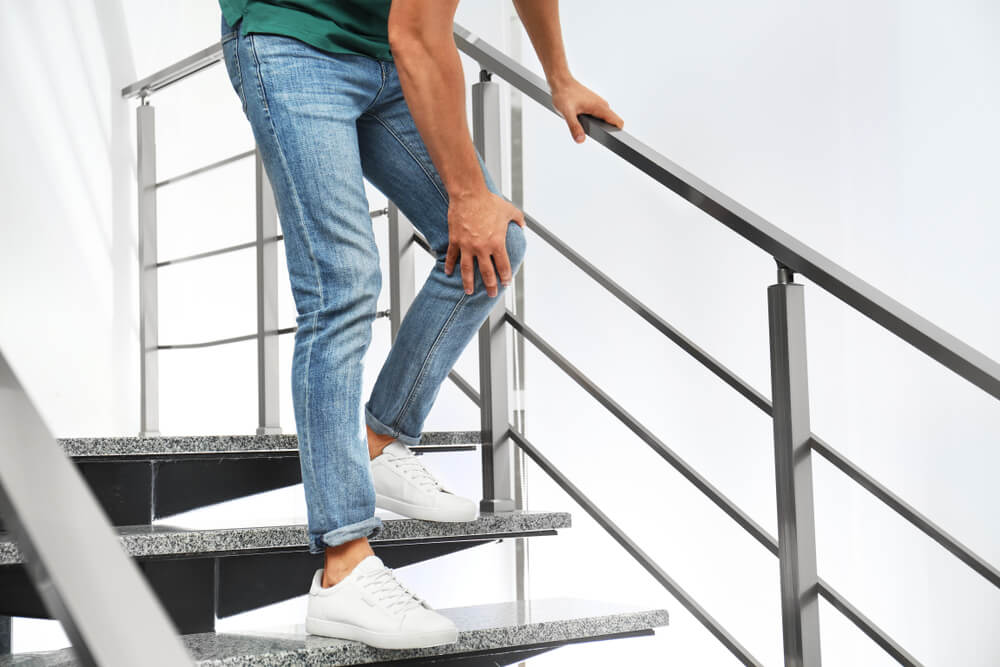Knee pain when walking down stairs can be a frustrating and concerning issue. Whether it’s a sharp pain, aching discomfort, or a feeling of instability, descending stairs often puts more strain on the knee joint than climbing up. If you’re experiencing knee pain during this activity, understanding the causes and treatment options can help you find relief.
In this article, we’ll explore why knee pain occurs when walking down stairs, common conditions that contribute to it, and the best ways to ease discomfort and strengthen your knees.
Why Does Knee Pain Get Worse When Walking Down Stairs?

When you walk downstairs, your knee joint experiences higher levels of pressure and impact. The forces exerted on the knee can be up to 3.5 times your body weight, making it a challenging movement for already weakened or injured knees.
Several factors can contribute to this pain, including:
Increased Knee Load: More force is placed on the knee joint when descending.
Weak Quadriceps Muscles: These muscles help control knee movement, and weakness can lead to strain.
Cartilage or Joint Issues: Damage to knee structures can make movement painful.
Inflammation or Previous Injuries: Swelling and past knee trauma may contribute to discomfort.
Common Causes of Knee Pain When Walking Down Stairs
1. Patellofemoral Pain Syndrome (Runner’s Knee)
- Occurs when the kneecap (patella) doesn’t track properly over the femur.
- Causes pain in the front of the knee, especially during activities that bend the knee, like descending stairs.
2. Osteoarthritis (Wear-and-Tear Arthritis)
- Degeneration of knee cartilage leads to pain, stiffness, and swelling.
- Pain is often worse after periods of inactivity and when using the knee joint extensively.
3. Chondromalacia Patella (Cartilage Softening)
- The cartilage under the kneecap wears down, causing pain when the knee is under stress.
- More common in young adults and athletes.
4. Meniscus Tear (Cartilage Injury in the Knee)
- A torn meniscus can cause sharp pain and difficulty moving the knee.
- Pain often increases with bending, squatting, and stair descent.
5. Patellar Tendonitis (Jumper’s Knee)
- Inflammation of the patellar tendon, which connects the kneecap to the shinbone.
- Pain is felt below the kneecap and worsens with activity.
6. Weak Quadriceps or Imbalanced Muscles
- The quadriceps help support the knee joint during movement.
- Weakness or imbalances can lead to instability and discomfort when going down stairs.
How to Relieve Knee Pain When Walking Down Stairs
1. Strengthening Exercises
Building strength in the quadriceps, hamstrings, and glutes can improve knee stability. Try:
✔ Straight Leg Raises – Strengthens the quadriceps without straining the knee.
✔ Wall Sits – Engages thigh muscles to improve knee support.
✔ Step-Ups – Helps train the knee joint for stair movements.
2. Stretching & Mobility Work
Tight muscles can put extra strain on the knee. Incorporate:
✔ Hamstring Stretches – Loosens tight muscles at the back of the thigh.
✔ Calf Stretches – Reduces tension that affects knee movement.
3. Use Proper Stair Walking Techniques
- Step down with the stronger leg first, followed by the weaker leg.
- Hold onto handrails for extra support.
- Avoid sudden, jerky movements that put stress on the knee joint.
4. Wear Supportive Shoes or Knee Braces
- Cushioned, supportive footwear can absorb impact and reduce knee strain.
- Knee braces or compression sleeves provide stability and pain relief.
5. Apply Ice & Heat Therapy
- Ice packs reduce swelling and numb pain after activity.
- Heat therapy relaxes stiff muscles and improves circulation before movement.
6. Use Over-the-Counter Pain Relievers (If Needed)
- NSAIDs like ibuprofen or naproxen can help reduce inflammation.
- Consider pain-relief creams for localized comfort.
Also Read: Sharp Stabbing Pain In Knee Comes And Goes At Night – Causes & Relief!
When to See a Doctor
Seek medical attention if you experience:
⚠ Severe pain that worsens over time.
⚠ Swelling, redness, or warmth around the knee.
⚠ Difficulty bearing weight on the affected knee.
⚠ A history of knee injuries that haven’t fully healed.
FAQ’s
1. Why does my knee hurt when walking down stairs but not up?
Walking down stairs puts more pressure on the knee joint, increasing strain on weakened muscles, cartilage, or ligaments, which can cause pain.
2. Can weak muscles cause knee pain when descending stairs?
Yes, weak quadriceps and imbalanced leg muscles can lead to instability, making it harder for the knee to absorb impact, resulting in discomfort.
3. What exercises can help relieve knee pain when going downstairs?
Strengthening exercises like straight leg raises, wall sits, and step-ups can improve knee stability and reduce pain.
4. Should I use ice or heat for knee pain after walking down stairs?
Use ice to reduce swelling and numb pain after activity, while heat therapy helps relax stiff muscles before movement.
5. When should I see a doctor for knee pain on stairs?
If pain is severe, worsening over time, accompanied by swelling, redness, or difficulty walking, consult a doctor for further evaluation.
Final Thoughts
Knee pain when walking down stairs can result from various conditions, including arthritis, muscle weakness, or patellar tracking issues. Strengthening exercises, stretching, proper movement techniques, and supportive gear can significantly help reduce pain and improve mobility. If knee pain persists despite home treatments, consult a doctor for a thorough evaluation and personalized treatment plan.
Related Post
- Zimatejigemo – Unlocking the Fusion of Creativity, Identity, and Innovation!
- Tinaypimatelate – The Revolutionary Concept Shaping the Future of Innovation!
- Limhuloxidpov – A Complete Guide to Understanding This Unique Concept!
- Zaxtexporoz – Exploring the Emerging Concept of Innovation and Digital Transformation!
- Lekulent – The Breakthrough Wellness Solution Taking the Health World by Storm!






